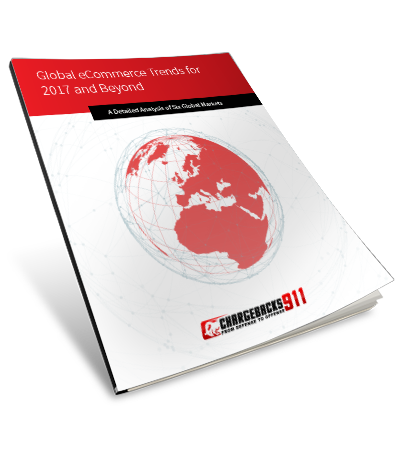Accepting Cross-Border Sales: Tips for Balancing Risk vs. Reward
Cross-border eCommerce is growing fast, as are the risk factors associated with such transactions. With the right tools and practices in place, though, merchants can enjoy the benefits of global expansion while still protecting themselves against loss.
Vast Potential for International Sales
Cross-border sales will account for a large share of eCommerce growth for the foreseeable future. Data published by DHL projects international transactions to grow 25% annually through 2020, representing an estimated 22% of all online transactions.
This correlates with an overall increase in online transactions, from $2 trillion in 2015 to an estimated $4.25 trillion in 2020, bringing cross-border eCommerce to roughly $900 billion a year.
The potential to profit from cross-border transactions is tremendous. Those already positioned to leverage international traffic will see significant growth in this sector over the next few years, translating to massive potential increases to their bottom line.
Cross-Border Opportunities Bring Challenges
Unfortunately, the challenges associated with cross-border eCommerce increase in tandem with the opportunities presented:
- Fraud Risk: eCommerce fraud risk varies substantially from one country to the next, with some nations showing rates of fraud attacks as high as 35% of all transactions.
- Regulatory Differences: Policies such as the EU’s General Data Protection Regulation or China’s proposed VAT for cross-border goods could provide competition-stifling barriers to entry.
- Legal Challenges: Some governments enforce strict fines for noncompliance with local rules. Resolving issues could prove costly without access to correct legal terms and conditions.
Global consumers don’t understand the obstacles merchants face, especially regarding payment processing risks. They expect to transact in the manner they are accustom to without additional friction—no matter the location of the seller.
This puts merchants in a difficult position—either live up to consumer expectation and accept greater cross-border risk, or play it safe and forfeit immense earning potential.
Pursuing Cross-Border Sales: Tips for Balancing Risk vs. Reward
Balancing the rewards of international eCommerce against the risk factors is a delicate process. However, once merchants are aware of the potential problems associated with international sales, they can take a proactive approach to risk mitigation.
Tip #1: Survey Alternate Payment Methods
While credit and debit cards are used to facilitate more than 80% of online transactions in the US, Canada, and the UK, global consumers have a much more diverse preference for payment methods.
“Research the alternate payment methods that are popular in the region you want to enter,” says Brennan Boyajian, Global Sales Executive at PayU. Moving into new markets may require accepting unfamiliar forms of payment because they are popular in that particular country or region.
Some examples of widely-used payment methods and services around the world include:
- Argentina: Rapipago, Pago Facil, Bapro, Cobro Express
- China: Alipay, Tenpay, Unionpay
- Germany: ELV Direct Debit, SOFORT
- India: Bank Transfer, Prepaid Cards, eWallet
- Mexico: Direct Cash (OXXO, 7 Eleven Transfer), Bank Transfer
- The Netherlands: IDEAL
- Russia: Qiwi, Webmoney, Yandex
Researching alternate payment methods will reveal associated risks and allow merchants to evaluate the viability for their particular businesses.
Tip #2: Review Fraud Trends Objectively
A reality of evaluating cross-border risk is that there are certain countries where fraud presents a very large problem. As reported by Forter, the top five countries for eCommerce fraud are:
| Nation of Origin | % of Transactions Identified as Fraud |
| Indonesia | 35% |
| Venezuela | 33% |
| South Africa | 25% |
| Brazil | 11% |
| Romania | 10% |
Based on this information alone, merchants might think that simply omitting these countries from an international strategy would solve a lot of problems. However, on closer inspection, it becomes obvious that fraud isn’t necessarily contained in small pockets around the world.
Venezuela and Brazil are noted for high fraud rates, but none of the other 12 countries in South America make the list—yet the continent’s fraud rate is 3 times higher than the global average. Likewise, South Africa is the third riskiest country in the world, but the entire African continent has a fraud rate 10 times higher than the global average.
Fraud is dynamic. It moves. It evolves.
It is advantageous to recognize which regions are more likely to produce fraudulent transactions, but attempting to avoid all risk is futile. International sales do carry a greater amount of risk, but there are ways to deal with it.
Those merchants who aren’t ready to accept greater fraud exposure aren’t ready for cross-border sales. Those who are will learn to detect region-specific indicators of fraud and adjust prevention tools accordingly.
Tip #3: Analyze IP Addresses
Another way to identify threats is by IP address analysis. “Look to see if the IP is a proxy,” says Tom Donlea, VP of Marketing at Whitepages Pro.
Donlea also suggests that merchants calculate the distance between the address provided and the IP address. If the IP address used to place an order does not correlate geographically with the billing address or the shipping address, it is possible that the order was placed by a fraudster.
Tip #4: Identify the Type of Phone Being Used
Donlea also points out that phone type is a characteristic that can be used to evaluate the potential for fraud, with non-fixed VoIP numbers being riskier.
- Fixed VoIP: A fixed VoIP number is registered to a region-specific address, typically a residential or business line that is simply serviced by a VoIP provider.
- Non-Fixed VoIP: These services can be associated with any address, meaning individuals can obtain a number in one country but reside in another.
As such, non-fixed VoIP numbers are the preference for fraudsters, as they are essentially disposable and anonymous. Therefore, transactions associated with these numbers should be considered highly suspicious.
“Whitepages Pro has a mobile app customer who was experiencing an overwhelming surge of new account abuse,” Donlea explains. “Once they used our data to determine which new accounts had a non-fixed VoIP number associated with them, they were able to route those applications through a process that required entering a credit card. Their fraud dropped over 80% in three short months.”
Tip #5: Examine Carrier Trends
Just as preferences for payment methods vary by region, the popularity of delivery service providers will fluctuate too. And, just as it is important to meet local expectations for payments, it is equally essential to work with the carriers that customers prefer.
However, carrier preferences can be an indicator for fraud. Donlea says, “Certain carriers in certain markets are more closely associated with fraud.”
Merchants need to carefully analyze data associated with known cases of fraud and friendly fraud to detect patterns. If evidence reveals fraudsters show a decided preference for a certain carrier, this intelligence needs to be added to fraud filter rules.
The request for a certain carrier, in and of itself, isn’t necessarily a red flag—but when combined with other indicators of fraud, merchants should take note.

The Essential Guide to Global eCommerce
Our new whitepaper takes a close look at eCommerce practices around the world. We carefully examined data on markets from Africa to Asia and beyond, all to assemble a thorough, predictive picture of where eCommerce is headed over the next several years.
FREE DOWNLOADTip #6: Scrutinize Email Account Data
A quick way to identify fraudulent activity is to check the email account associated with the order.
“The email creation date is a quick clue,” says Donlea. “Was it created yesterday? If so, it carries a higher risk for fraud.”
Merchants can also look at the characters used in the email address as a potential clue. A jumbled or seemingly nonsensical email address suggests that it was created with the intention of being disposable.
Tip #7: Get Help from Professionals
Most merchants do not have the expertise or available in-house resources that are needed to create an effective risk mitigation plan for each region they intend to enter. In most cases, the best way to minimize cross-border risk is to get help from the professionals. But, not just any professionals—professionals with expertise in the regions you want to enter.
To explain the value of this suggestion, Boyajian used his own company as an example: "PayU supports 16 different countries. We have experts on the ground to better understand how local consumers transact, and we work very closely with the local financial institutions to minimize fraud.”
Chargebacks911® also understands the significance of engaging local experts while serving an international clientele. We have locations throughout North America, Europe, and Asia to offer on-demand, region-specific expertise to our merchants.
Expert Help in Mitigating Cross-Border Risk
The risks associated with cross-border eCommerce will only continue to grow as the need to operate on a global scale becomes more and more pressing. Fortunately, there are ways to minimize risk to ensure international sales increase profitability—not liability.
If you’d like to add comprehensive chargeback management to your international risk mitigation strategy, contact Chargebacks911 today. We’d be happy to connect you to the local experts we have working in the regions you wish to enter.










